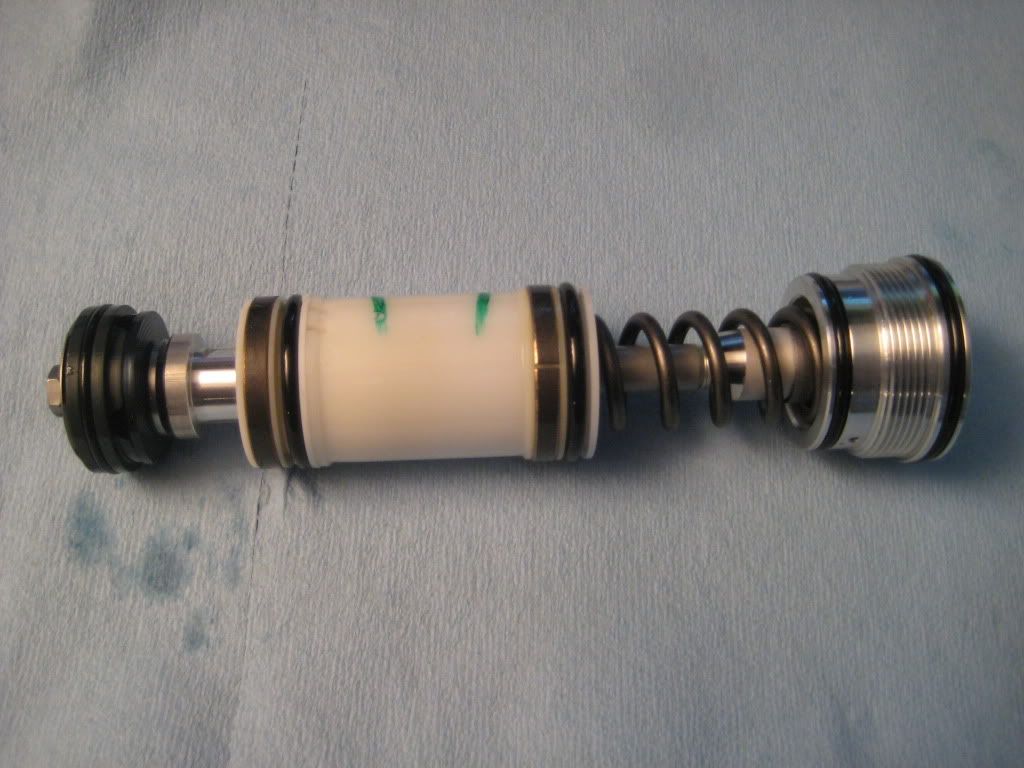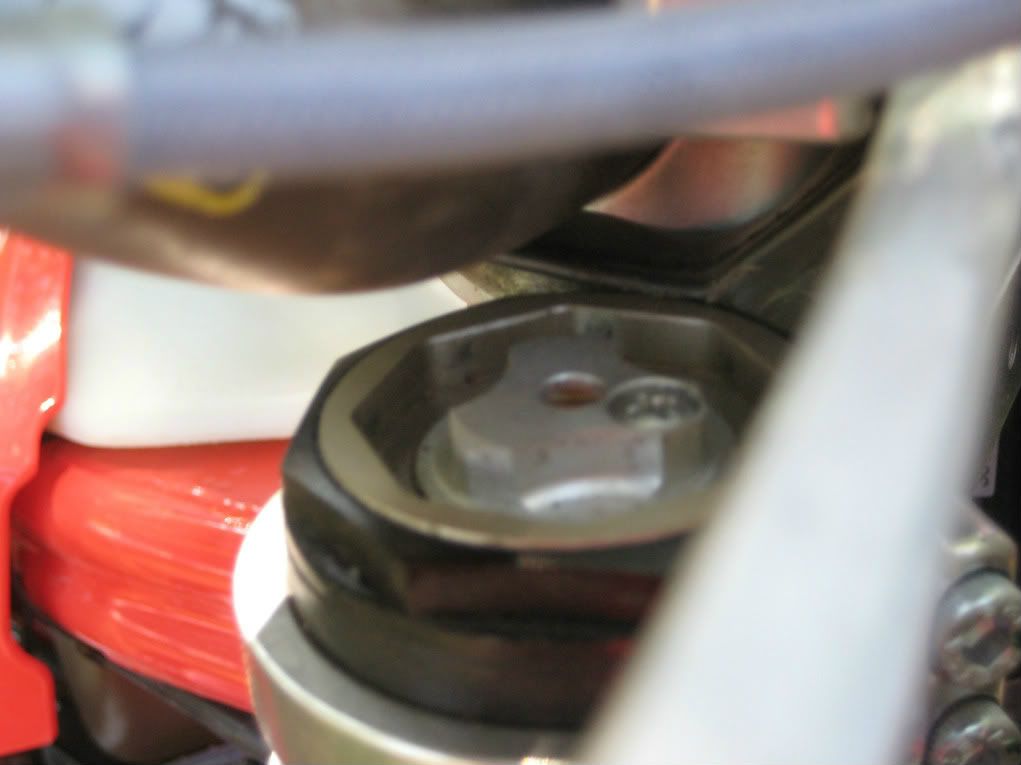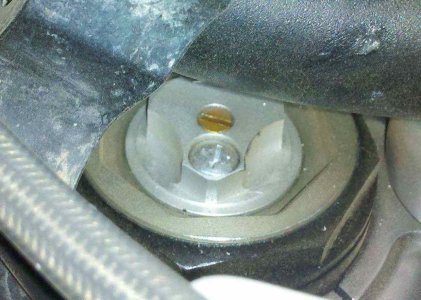Looking for my first gasgas, and demo'd a nice 09 ec300 with sachs front and rear today. Loved the motor, but I was a bit disappointed in the feel of the front end; it felt kinda like my kdx....a bit unsecure on open sections (or maybe sketchy, not confidence inspiring). I was hoping it would handle like my buddies 2011 250 (ohlins/zoke) which feels more planted. Did the geometry change at all between the 09 and the 11? Or is this something that can be fixed with setup/fork height/rear preload/etc. I am 165# and the 09 had stock springs, no revalve work. Thanks for any insights.
You are using an out of date browser. It may not display this or other websites correctly.
You should upgrade or use an alternative browser.
You should upgrade or use an alternative browser.
Newbie Handling Question
- Thread starter rxmx
- Start date
noobi
New member
Its just the stock set up of the sachs forks. The geometry is the same, as far as I know. Someone will chime in with some more reputable suspension tuners who can get the forks to work better.
I know of http://lt-racing.com/ there are a lot of people who can vouch for Les' work.
I know of http://lt-racing.com/ there are a lot of people who can vouch for Les' work.
Looking for my first gasgas, and demo'd a nice 09 ec300 with sachs front and rear today. Loved the motor, but I was a bit disappointed in the feel of the front end; it felt kinda like my kdx....a bit unsecure on open sections (or maybe sketchy, not confidence inspiring). I was hoping it would handle like my buddies 2011 250 (ohlins/zoke) which feels more planted. Did the geometry change at all between the 09 and the 11? Or is this something that can be fixed with setup/fork height/rear preload/etc. I am 165# and the 09 had stock springs, no revalve work. Thanks for any insights.
Spring and re-valve for your weight and ability. It will be the best money you can spend. GasGas bikes are sprung 5.2 rear (not sure on those forks) which is for about a 145lb rider. There is a ton of info right here on this forum to help you out if you want to do some changes yourself.
Berkyboy
Site Sponsor
I'd recommend checking the rear sag first. 110 to 115mm is a good starting point. I'd also raise the forks (move them up) slightly in the front triple clamp 3/16 to a 1/4 inch.
I've personally found that the 2005 and newer bike geometry handle better if you adjust your handlebar perches/ clamps to the furthest back position. Especially if you're 5' 10" or less.
Make each of these adjustments one at a time.
If the rear shock is sprung at 5.2 the front forks would typically be at .42.
Steve
I've personally found that the 2005 and newer bike geometry handle better if you adjust your handlebar perches/ clamps to the furthest back position. Especially if you're 5' 10" or less.
Make each of these adjustments one at a time.
If the rear shock is sprung at 5.2 the front forks would typically be at .42.
Steve
My '10 GG 300 feels great with the Sachs, and it is still stock with the stock oil in both ends.
I had a long break in period where the forks felt harsh, but right now the bike feels fine.
My forks are at the 1st line under the caps, 110mm sag, 30mm free sag, 5.2 spring. I noticed that if I raised the forks or went to 100-105 sag, the bike got a little squirrely on long straights and higher speeds. The HS compression adjuster on the rear shock has much to do with how high the rear end rides when the bike is in motion too. Mine is 1 1/2 turns out.
I think in terms of clickers, it is hard to quantify the number of clicks, especially on a Sachs shock, there seems to be a lot of variation on the number of clicks for each adjuster setting for each different year of bike.
I think triple clamp offset is 22mm for recent years.
I had a long break in period where the forks felt harsh, but right now the bike feels fine.
My forks are at the 1st line under the caps, 110mm sag, 30mm free sag, 5.2 spring. I noticed that if I raised the forks or went to 100-105 sag, the bike got a little squirrely on long straights and higher speeds. The HS compression adjuster on the rear shock has much to do with how high the rear end rides when the bike is in motion too. Mine is 1 1/2 turns out.
I think in terms of clickers, it is hard to quantify the number of clicks, especially on a Sachs shock, there seems to be a lot of variation on the number of clicks for each adjuster setting for each different year of bike.
I think triple clamp offset is 22mm for recent years.
Jakobi
Super Moderator
My '10 GG 300 feels great with the Sachs, and it is still stock with the stock oil in both ends.
I had a long break in period where the forks felt harsh, but right now the bike feels fine.
My forks are at the 1st line under the caps, 110mm sag, 30mm free sag, 5.2 spring. I noticed that if I raised the forks or went to 100-105 sag, the bike got a little squirrely on long straights and higher speeds. The HS compression adjuster on the rear shock has much to do with how high the rear end rides when the bike is in motion too. Mine is 1 1/2 turns out.
I think in terms of clickers, it is hard to quantify the number of clicks, especially on a Sachs shock, there seems to be a lot of variation on the number of clicks for each adjuster setting for each different year of bike.
I think triple clamp offset is 22mm for recent years.
Definite changes in the internal valving of the Sachs fork between 09 and 10
Thanks for the replies. I took the plunge and bought a new 250 race, which replaces my well used and loved kx-forked kdx220. Anyone have info on the 48mm Zokes? Is the triangular shaped "knob" in the center of the fork cap a preload adjuster? Tried to attach pic.
I'll update as my setup progresses.
I'll update as my setup progresses.
Attachments
Clay
Banned
Thanks for the replies. I took the plunge and bought a new 250 race, which replaces my well used and loved kx-forked kdx220. Anyone have info on the 48mm Zokes? Is the triangular shaped "knob" in the center of the fork cap a preload adjuster? Tried to attach pic.
I'll update as my setup progresses.
There is a preload adjuster but it is a circlip that has to be changed internally. The tri shaped knob is called a PFP adjuster. Don't know what it stands for. It adjusts compression and rebound much more than the clicks of the compression and rebound adjuster. The Zoke guy told me they were able to turn that knob in a couple of turns and do full moto with the fork. I have no clue how it works. I have been meaning to ask for a better explanation but procrastination is my middle name.
Here are the basic setting on the Zoke fork:
Fork shiver 48mm. Gas Gas
Compression : 20 out
Rebound : 20 out
Spring : K .42
Preload : 05mm (3rd up)
Spring cart. : K 20
PFP : 02 turn in
Oil : Marzocchi 7,5 wt. Spectro 125/150
Oil level : 330cc
Oil level in the cart. : 145mm.
Clay
twowheels
New member
The tri shaped knob is called a PFP adjuster. Don't know what it stands for.
PFP = Progressive Floating Piston
I've been trying to contact Italy through my Tenneco contacts, but for now the internals are a mystery.
Clay
Banned
PFP = Progressive Floating Piston
I've been trying to contact Italy through my Tenneco contacts, but for now the internals are a mystery.
I've asked the US Zoke guys. So far the crickets are still chirping.
GMP
Active member
I wonder if Les has seen any yet. Progressive floating piston sounds just like a piston shock resovoir design to me (Ohlins, Sachs, WP) vs a bladder design, with a spring behind it instead of compressed nitrogen. The concept of CC forks is simply to keep the oil clean and from becoming mixed with air, prevent cavitation, and provide more consistant damping. My biggest question is how hard is it to service in the garage for the average guy, and what if any special tools are required.
Clay
Banned
I got this back from my contact at Marzocchi:
PFP system:
The PFP (Progressive Floating Piston) System is a new adjustment on our USD48 fork and it's patented because our competitors don't have this
feature. PFP System is an external adjustment, on the caps of both sliders, in addition to the compression and rebound adjusters. Its aim is to modify
the pressurization level of the sealed cartridge in order to increase the range of the hydraulic load. Through the PFP System the Tenneco Marzocchi
USD48 fork is the fork with the biggest hydraulic range in the market using the external adjustments
So rather than changing oil flow like the compression and rebound clickers do, the PFP valve increases the pressure of the sealed/closed cartridge.
Clay
PFP system:
The PFP (Progressive Floating Piston) System is a new adjustment on our USD48 fork and it's patented because our competitors don't have this
feature. PFP System is an external adjustment, on the caps of both sliders, in addition to the compression and rebound adjusters. Its aim is to modify
the pressurization level of the sealed cartridge in order to increase the range of the hydraulic load. Through the PFP System the Tenneco Marzocchi
USD48 fork is the fork with the biggest hydraulic range in the market using the external adjustments
So rather than changing oil flow like the compression and rebound clickers do, the PFP valve increases the pressure of the sealed/closed cartridge.
Clay
Due to work, won't be able to play with the forks for about 4 days. I had to back off the shock spring preload to 3.5mm to get 110mm sag, with stock 5.2 spring (Ohlin shock)...I weigh 160# empty, only 2hr on bike. Can I expect the spring to "loosen" up after some time, seems a bit stiff for a 5.2......?
Clay
Banned
I think I get what it is now. Its like a preload adjuster for the cartridge spring. Clay, have you tried adjusting yours? It would be very cool to set the fork up plush enough for rocks and be able to dial in more resistance for the faster stuff.
Jeff Melik has prolly played around with this more than anyone. I will ask him to jump in on this.
I haven't ridden anything fast yet so I haven't had an opportunity to try it. I'm gonna do some hare scrambles in the next few weeks so I may give it a try.
Jeff Melik
New member
The pfp adjuster is really a lot more simple than it seams. By adjusting it in or out you are changing the ammount of force that is on the piston in the chamber. Basically by tightening the adjuster you are causing the piston to resist allowing the oil to pass through the valve and into the chamber. It is the exact same setup as a kyb fork accept that there is an external adjuster. On a kyb you can change the spring rate or ad shims to achieve the same thing. Stock setup on a kyb is with zero preload on the chamber spring. Thats what makes the zokes so good is that there is no disassembly required for adjustment.
As far as actual settings go my standard setting is all the way out. For more open stuff or moto ill add a turn or two. I tried a softer main spring rate in hopes that i could add some turns to make up for the lighter springs but there is a threshold with the pfp where it will start to deflect because you are esentially stiffening the valving not the spring. My recomendation is to use whatever spring you would normally use and start with the pfp all the way out. Id only use the pfp if you need a little more botoming resistance.
Hope this clears some stuff up and i didnt add to any confusion.
As far as actual settings go my standard setting is all the way out. For more open stuff or moto ill add a turn or two. I tried a softer main spring rate in hopes that i could add some turns to make up for the lighter springs but there is a threshold with the pfp where it will start to deflect because you are esentially stiffening the valving not the spring. My recomendation is to use whatever spring you would normally use and start with the pfp all the way out. Id only use the pfp if you need a little more botoming resistance.
Hope this clears some stuff up and i didnt add to any confusion.
twowheels
New member
CC Fork Diagram
Here's a shot of the famed KYB SSS compression assembly.

From right to left: The pressure spring can be seen under the cap, and then there is the nylon piston, and finally the compression valve assembly. Essentially when the fork compresses oil is forced through the valve assembly (on the left side) into a chamber stopped by the nylon piston. As more oil is forced through, the piston can move until the pressure is equalized by the spring.
Analogously the PFP system gives you the ability to increase or decrease the stiffness of the pressure spring.
Here's a shot showing the three-pointed PFP adjuster in the center of the fork cap, with the standard compression adjuster in the center of that.

Here's a shot of the famed KYB SSS compression assembly.

From right to left: The pressure spring can be seen under the cap, and then there is the nylon piston, and finally the compression valve assembly. Essentially when the fork compresses oil is forced through the valve assembly (on the left side) into a chamber stopped by the nylon piston. As more oil is forced through, the piston can move until the pressure is equalized by the spring.
Analogously the PFP system gives you the ability to increase or decrease the stiffness of the pressure spring.
Here's a shot showing the three-pointed PFP adjuster in the center of the fork cap, with the standard compression adjuster in the center of that.

Similar threads
- Replies
- 23
- Views
- 10K

